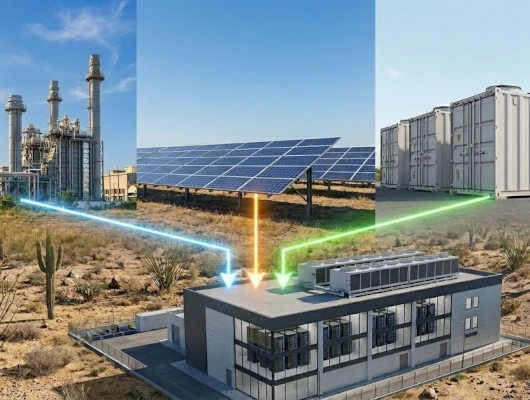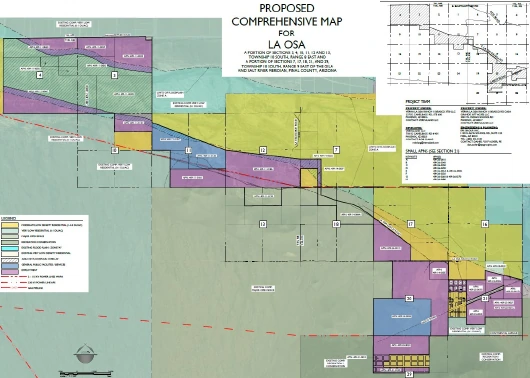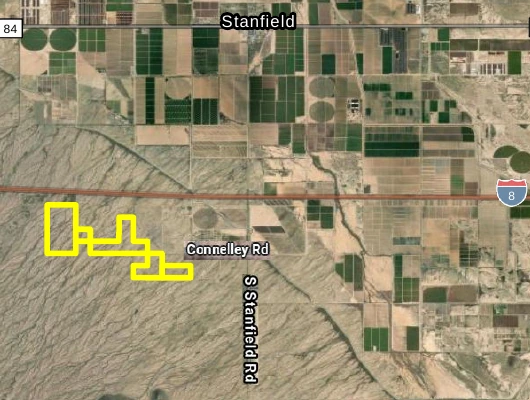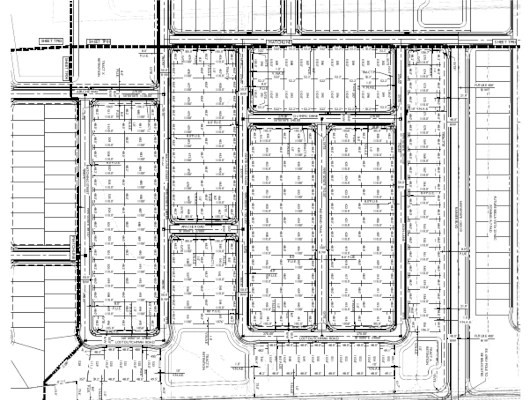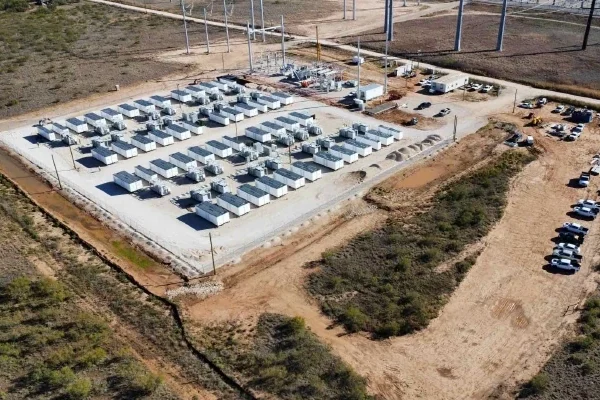At a Glance
- Supervisors approved the 2,685-acre Griffin Energy Project in a 4–1 vote.
- The site will use solar, batteries, and natural gas to power a nearby data center.
- All energy will stay local, according to ED3.
- The project sits along I-8 southeast of Stanfield, between two major washes.
- Parts of the site lie in a floodplain, requiring drainage mitigation.
- The location was chosen for its substation, gas line, and transmission access.
- Fire officials expect a developer-funded agreement for added resources.
- Economic estimates show 500+ jobs and over $1.1B in tax revenue.
- Opponents raised concerns about flooding, battery leakage and solar disposal. They also requested setbacks and firm decommissioning requirements.
- Ak-Chin representatives cited air and flooding concerns.
- The project now moves to rezoning.
The Pinal County Board of Supervisors approved the Griffin Energy solar gas battery project on November 19, 2025. The board voted 4-1 to advance the 2,685-acre energy complex. Supervisor Jeff Serdy cast the lone no vote. The project will power a nearby data center campus that the board also approved at the same meeting.
Court Rich of Rose Law Group, representing the applicant, presented the project to supervisors.
What the Griffin Energy Project Includes
The Griffin Energy Project will convert 2,685 acres of mostly agricultural land into energy production. The facility combines three power sources: solar panels, battery storage, and natural gas generation. This mix is designed to serve a specific customer—the nearby data center—rather than export power elsewhere.
The Citizens Advisory Committee recommended approval on an 11-2 vote. The Planning and Zoning Commission followed with a 6-2 recommendation. Both groups forwarded the case to supervisors with no stipulations.
Location and Infrastructure Connections
The project site sits between the Santa Rosa Wash and Greene Wash on both sides of Interstate 8. The land lies about three miles southeast of Stanfield. Most of the property currently operates as farmland. A significant wash runs through the area. Most of the site falls within a flood zone.

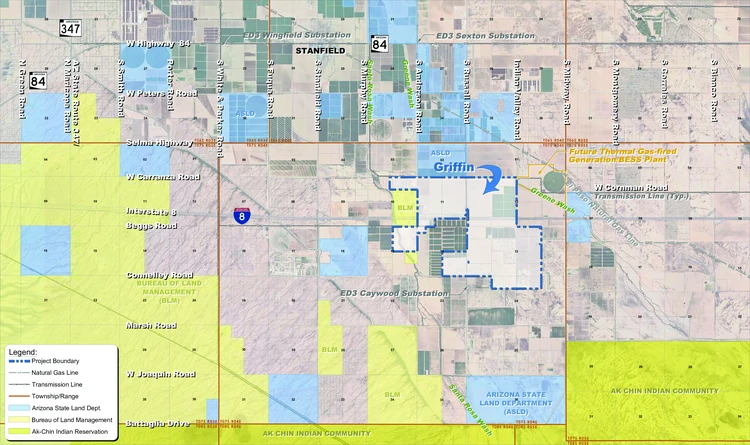
Chairman Stephen Miller asked staff about development requirements in flood areas.
“If we’re gonna develop something in a floodplain, is there a requirement by the Pinal County Flood Control District to mitigate that and mitigate any issues downstream and even upstream?” Miller asked.
Senior Planner Glenn Bak confirmed that a drainage report would be required. He said there are setback requirements for wells and washes, though he deferred to engineering for specifics.
Rich explained why developers chose this location. The ED3 Caywood Substation sits immediately adjacent to the project. The El Paso natural gas line runs to the northeast. Major transmission lines cross the area. This infrastructure makes the site ideal for power generation.
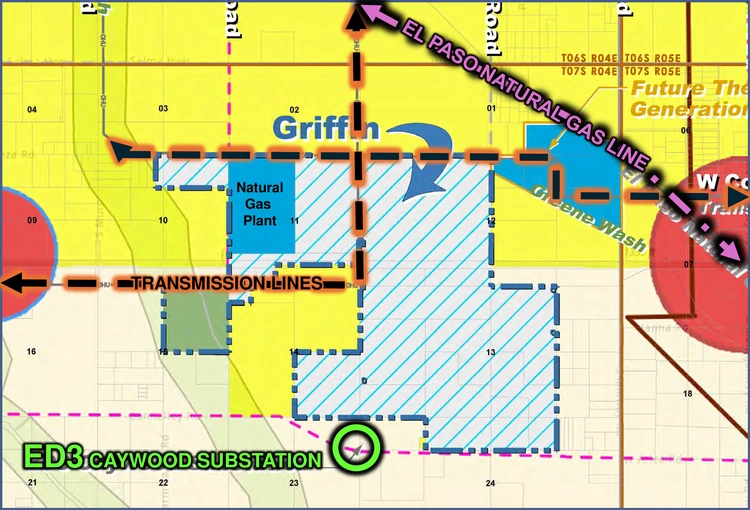
“That’s really the why we’re here, because we’re trying to service this data center in ED3 service territory,” Rich said. “Having this substation right there is key.”
Why the Project Uses Three Power Sources
The energy mix serves a strategic purpose. Data centers need constant, reliable power. Solar alone cannot meet that demand around the clock. Natural gas fills the gaps. Battery storage helps manage the grid and keep prices stable.
Rich explained the economics behind this approach.
“What you need when you’re providing power to a big user is a mix of resources,” Rich said. “Both to manage the grid correctly and also to be able to arbitrage and keep prices low.”
He noted that clean energy appeals to major technology companies.
“A lot of the entities that want to locate in data centers require a certain amount of clean energy,” Rich said. “Being able to offer clean energy as an option will help attract businesses.”
Solar provides predictable costs.
“The price of the sun never goes up or down,” Rich said. “If there’s a storm in Texas, our gas prices go way up. The sun just costs what it costs.”
Native Vegetation Under Solar Panels
Supervisor Jeff Serdy asked why developers don’t place solar panels on data center buildings instead of open land.
“Why not put solar on those buildings so that we don’t have to use so much of the desert for solar?” Serdy asked. “There’s gonna be hundreds and hundreds of acres of buildings there.”
Rich cited scale and cost.
“The amount of solar you can put on the ground and the lower cost of doing it, it’s better for ratepayers,” Rich said. “The economies of scale are better.”
Rich addressed concerns about barren desert beneath solar arrays. He showed photos from Copia’s Harquahala project where native grasses grow under the panels.
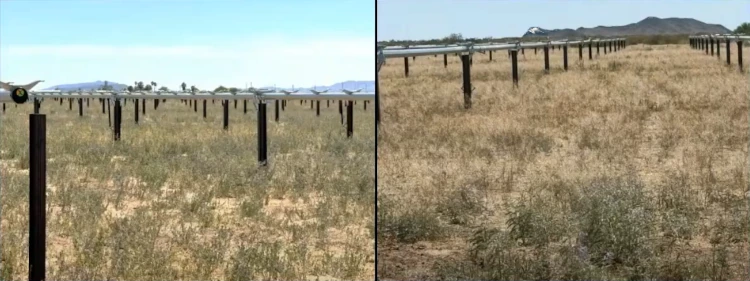
“They use native seed, we’re happy to stipulate to this when we come to zoning, to not leave you with this barren wasteland situation underneath your solar panels,” Rich said.
“Much of this area is farmed currently, so they’re not wiping out a blank desert,” Rich added.
Electrical District 3 Confirms Project Viability
Brian Yerges, general manager of Electrical District Number Three, spoke in support. He confirmed that ED3 has worked with developers on technical requirements.
“I’m here to let you guys know that this is a real project,” Yerges said. “The power will go to support a project within our service territory. This is not going to California. It’s not going up in the valley. It’s gonna stay here locally.”
Yerges explained that the developer made substantial deposits to fund interconnection studies. This protected regular customers from subsidizing development work.
He confirmed where the power goes.
“100% of the energy from this facility will go to the data center,” Yerges said.
Yerges described how ED3 structured the arrangement to benefit existing customers.
“We’re gonna structure it in a way that other customers are not subsidizing this project, but there’ll be incremental revenue or margin from this project which will help our core customer base,” Yerges said. “Inflation has been a factor in the utility industry. Things cost a lot more today than they did five years ago, and so that revenue will help us support other investments in our system.”
Fire Protection Plans
Fire coverage drew questions from Supervisor Rich Vitiello. Arizona City Fire District Chief Jeff Heaton outlined the plan.
“We’re going to get a financial contribution agreement in 2026,” Heaton said. “Very similar to Project Bella.”
He noted that Project Bella already plans to build a firehouse nearby.
“We don’t need to put a firehouse right next to every one of these power plants,” Heaton said. “What we do need is additional resources and equipment.”
Rich confirmed developer participation.
“We anticipate participating in the funding of whatever Chief Heaton deems necessary for the area,” Rich said. “We’re bringing more reliable fire service not just to the project, but to the area.”
Heaton described broader goals for fire coverage.
“We wanna form and provide fire and EMS and life safety services starting in 2026 to these areas,” Heaton said. “So we want to not only grow PCFMA, Pinal County Fire Medical Authority, in 2026, but also start helping some of the smaller fire districts that are in those areas that are ancillary to these areas that cannot do it financially.”
Economic Impact Numbers
Rich presented economic projections from Elliott Pollack & Company for the data center that this energy project would power.
Jobs:
- 500+ on-site jobs
- 588 indirect jobs in the community
Wages:
- $66 million annually (operational)
- $500 million in construction wages
Tax Revenue:
- $44 million annually (all jurisdictions)
- $9 million annually (county)
- $125 million over 25 years (local schools)
- $1.1 billion over 25 years (total)
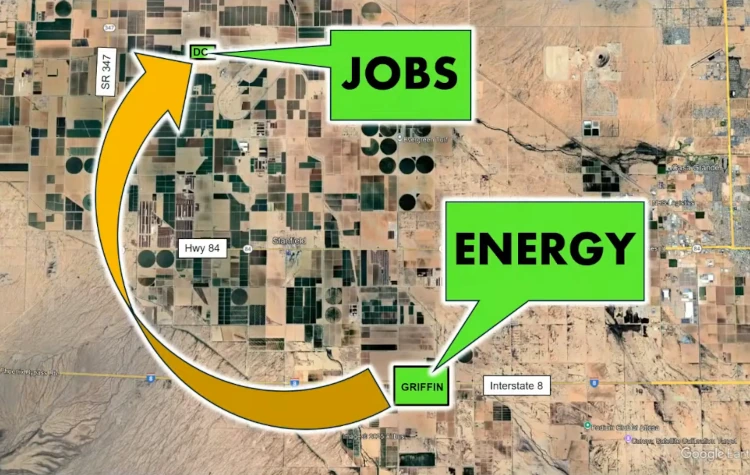
Rich emphasized these benefits stay local because the power serves a local customer.
Public Comments Against the Project
Maryeileen Flanagan from Hidden Valley opposed the project. She raised concerns about battery leakage near the washes.
“What happens if the batteries leak right there next to that Santa Rosa Wash and that Greene Wash?” Flanagan asked. “Both of those washes flood regularly.”
She requested setbacks from the washes.
“I’d like to see a stipulation to set it back 125 feet from the wash to protect the groundwater,” Flanagan said.
She also questioned what happens when solar panels reach end of life.
“When the solar panels are no longer useful, what happens to them?” Flanagan asked. “Many go into storage containers and they’re just stacked up. There’s no recycling protocol. I worry about what will happen to our desert when this is finished. Probably the open space and the solar are my biggest reasons for objecting.”
Robin Davis, a member of the Open Space and Trails Commission, took a measured stance.
“I realize this corridor along [I-]8 and [SR-]84, it’s gonna be an energy corridor,” Davis said. “I don’t think there’s anything that any of the residents can say or do to change your minds. All we can do is ask for much stricter stipulations.”
Davis emphasized the need for clear decommissioning plans.
“None of these solar companies, no matter how many open houses I go to, no matter how many meetings, they really don’t know what the decommissioning looks like,” Davis said. “We have to have positive answers on that, and not just, ‘Well, this is what’s planned.'”
She urged accountability.
“We need to hold the companies accountable and to have stricter stipulations,” Davis said.
Ak-Chin Community Members Voice Concerns
Representatives from the Ak-Chin Indian Community attended the hearing. Vice Chairman Delia Carlyle explained their primary concern related to the data center project next on the agenda. However, flooding affected both projects.
“There are four washes that run through Ak-Chin and Santa Rosa is one of them, Santa Cruz is another, Vekol, Smith, all run through the community,” Carlyle said.
Roman Gabriel Orona, the community’s Environmental Programs Manager, raised air quality concerns.
“Air quality is gonna be huge,” Orona said. “Maricopa County is dealing with a huge air quality issue. And these systems will also be off-gassing.”
He described flooding impacts on the community.
Orona said the community is “left holding the bag with all the floods” as water flows into their land and threatens homes.
Orona called for looking at cumulative effects rather than approving projects one at a time.
“We’re thinking about these things one-offs,” Orona said. “And I think we need to really take a look at the cumulative effects when it comes to land conservation, the habitat, the biological resources.”
Arizona Technology Council Support
Cepand Alizadeh spoke for the Arizona Technology Council.
“Arizona Technology Council is a big advocate for an all-of-the-above approach to meet our rising energy needs,” Alizadeh said. “This means that we need to invest in solar, other renewables, natural gas.”
He connected energy development to population growth.
“Pinal County’s population grew by 21.5%,” Alizadeh said. “We have to invest in these projects to really power the growing community and meet their power needs.”
Landowner Explains Water Transfer Benefits
Dan Thelander farms most of the project site. His family manages 3,400 acres in the area. They lost water access when the Maricopa Stanfield Irrigation District lost its CAP allocation.
“Because our water district, Maricopa Stanfield, lost our CAP allocation a few years ago, we can only farm about 40% of the land that we would be farming had we had more water,” Thelander said. “60% of it is fallow.”
He described problems with unused farmland.
“There’s no crops on it, the weeds grow up, we have to disk the weeds down, it creates a dust issue,” Thelander said.
Thelander explained that converting land to solar would redirect water to neighboring farms.
“Most, if not all, of the well water will be transported off the site through pipes and canals to other neighboring area farms who are also short of water,” Thelander said. “When our 1,400 acres go out of production, 1,400 additional acres are gonna go into production in other adjoining areas.”
Developer Responses to Concerns
Rich addressed flooding and environmental concerns in his closing remarks.
“The battery energy storage is being sited outside of the floodplain,” Rich said.
He described drainage improvements.
“We’re gonna be installing some retention basins as well that don’t exist out there today,” Rich said. “We’re required by state law to make sure that the water leaving the property is the same as it was historically.”
Rich confirmed no development in the washes.
“We’re not developing in any of the washes, so none of the infrastructure will be placed in any of the washes,” Rich said.
He noted that open space would actually increase.
“When this is over, we’re preserving more area as open space than is designated open space today,” Rich said.
On decommissioning, Rich committed to formal plans.
“There will be a decommissioning plan and a decommissioning bond in place, and through the zoning process, we can work that out with you and your staff,” Rich said.
Rich described cooperation with Arizona Game and Fish.
“Copia has done several projects in the state of Arizona, and they’ve got a long history of working very closely with the Arizona Game and Fish Department,” Rich said. “We met last week on this project, and Game and Fish is very happy with the way that they’re preserving the washes and protecting the riparian habitats.”
Supervisor Rich Vitiello asked about communication with the Ak-Chin community. Rich confirmed face-to-face engagement.
“We’ve previously had face-to-face, walk the site meetings with them,” Rich said. “We have opened ourselves up to an invitation that we will come and speak to them whenever they want.”
Data Center Also Approved
The board approved the companion data center project later in the same meeting. That project, called the Energy Generation and Technology Campus, sits near the City of Maricopa and the Ak-Chin Indian Community. The Griffin Energy Project exists specifically to power that facility.
Rich told supervisors this connection makes Griffin Energy unique among solar proposals they have reviewed.
“This is the first time you’ve seen one that’s really enabling growth in the county,” Rich said. The energy stays in Pinal County to power the data center rather than being exported elsewhere.
The project now moves to the rezoning phase. Rich said stipulations for vegetation management, fire protection, and decommissioning will be addressed during the zoning process. The applicant must now pursue rezoning before construction can begin.
Previous Coverage
This article continues coverage of the Griffin Energy Project. For additional details on flooding concerns, temperature effects research, agrivoltaics, and the Planning and Zoning Commission hearing, see our previous article: Commission Advances Griffin Energy Solar, Gas, and Battery Project for Data Centers
For the initial work session coverage and project overview, see: New Griffin Energy 2,685-Acre Solar-Gas-Battery Proposal Faces Flooding Concerns at Pinal County Planning Session
